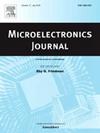A transimpedance amplifier with 99.8-dBΩ transimpedance gain and 400-MHz bandwidth for pulsed ToF Lidar receiver applications
IF 1.9
3区 工程技术
Q3 ENGINEERING, ELECTRICAL & ELECTRONIC
引用次数: 0
Abstract
This paper presents a high gain, broad bandwidth and low noise transimpedance amplifier (TIA) for pulsed time of flight (ToF) Lidar applications. The proposed TIA consists of a single-end transimpedance preamplifier (preTIA) with frequency compensation and over-current protection, a post voltage amplifier (PVA) with local feedback unit and fully differential architecture, and a gm-C integrator to generate the common-mode input voltage for the PVA. Designed and implemented in a 0.18-μm standard CMOS technology, the proposed TIA typically achieves a single-end transimpedance gain of ∼99.8 dBΩ, a bandwidth of ∼400 MHz, an input-referred noise current density of ∼2.3 pA/Hz0.5, a minimum detectable current signal (MinDS) of ∼0.4 μArms at SNRmin = 9, a maximum detectable current signal (MaxDS) of ∼20 mApp.
具有99.8-dBΩ跨阻增益和400-MHz带宽的跨阻放大器,用于脉冲ToF激光雷达接收器应用
介绍了一种适用于脉冲飞行时间激光雷达的高增益、宽带宽、低噪声跨阻放大器。所提出的TIA由具有频率补偿和过流保护功能的单端跨阻前置放大器(preTIA)、具有局部反馈单元和全差分结构的后电压放大器(PVA)和用于产生PVA共模输入电压的gm-C积分器组成。该TIA采用0.18 μm标准CMOS技术设计和实现,单端跨阻增益为~ 99.8 dBΩ,带宽为~ 400 MHz,输入参考噪声电流密度为~ 2.3 pA/Hz0.5, SNRmin = 9时最小可检测电流信号(MinDS)为~ 0.4 μArms,最大可检测电流信号(MaxDS)为~ 20 mApp。
本文章由计算机程序翻译,如有差异,请以英文原文为准。
求助全文
约1分钟内获得全文
求助全文
来源期刊

Microelectronics Journal
工程技术-工程:电子与电气
CiteScore
4.00
自引率
27.30%
发文量
222
审稿时长
43 days
期刊介绍:
Published since 1969, the Microelectronics Journal is an international forum for the dissemination of research and applications of microelectronic systems, circuits, and emerging technologies. Papers published in the Microelectronics Journal have undergone peer review to ensure originality, relevance, and timeliness. The journal thus provides a worldwide, regular, and comprehensive update on microelectronic circuits and systems.
The Microelectronics Journal invites papers describing significant research and applications in all of the areas listed below. Comprehensive review/survey papers covering recent developments will also be considered. The Microelectronics Journal covers circuits and systems. This topic includes but is not limited to: Analog, digital, mixed, and RF circuits and related design methodologies; Logic, architectural, and system level synthesis; Testing, design for testability, built-in self-test; Area, power, and thermal analysis and design; Mixed-domain simulation and design; Embedded systems; Non-von Neumann computing and related technologies and circuits; Design and test of high complexity systems integration; SoC, NoC, SIP, and NIP design and test; 3-D integration design and analysis; Emerging device technologies and circuits, such as FinFETs, SETs, spintronics, SFQ, MTJ, etc.
Application aspects such as signal and image processing including circuits for cryptography, sensors, and actuators including sensor networks, reliability and quality issues, and economic models are also welcome.
 求助内容:
求助内容: 应助结果提醒方式:
应助结果提醒方式:


